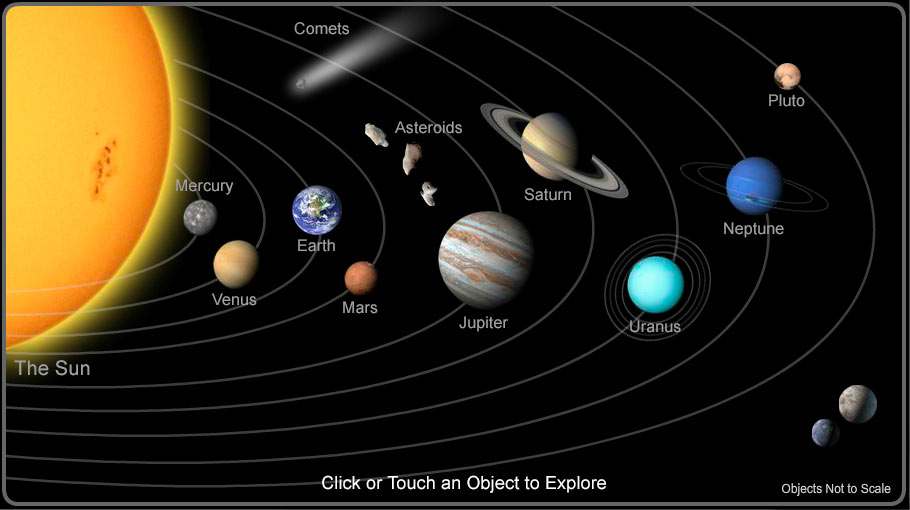Our solar system is a vast expanse of space that stretches over 4.5 billion kilometers from the sun to the orbit of the dwarf planet Pluto. Along the way, there are eight major planets and a host of other objects that make up the planetary neighborhood we call home.
Let’s start our tour by visiting the planet closest to the sun, Mercury. This small, rocky planet is only slightly larger than Earth’s moon, and it orbits the sun at a distance of only 58 million kilometers. As a result, temperatures on the surface can reach a scorching 430 degrees Celsius during the day and drop to a frigid -180 degrees Celsius at night.
Next up is Venus, the hottest planet in our solar system. Despite being similar in size and composition to Earth, Venus has a thick atmosphere that traps heat and causes temperatures on the surface to soar to a blistering 470 degrees Celsius. With its swirling clouds of sulfuric acid and intense greenhouse effect, Venus is a hostile and inhospitable place.
Mars, on the other hand, is a planet that has long captured our imagination. With its rust-colored surface and polar ice caps, Mars is often referred to as the “Red Planet.” Although much colder and drier than Earth, Mars has a thin atmosphere that could potentially support human exploration and even colonization in the future.
Jupiter is the largest planet in our solar system, with a diameter of more than 142,000 kilometers. This gas giant has a colorful array of cloud bands and a giant, swirling storm known as the Great Red Spot. Jupiter is also home to more than 80 moons, including four large ones known as the Galilean moons: Io, Europa, Ganymede, and Callisto.
Saturn is perhaps best known for its spectacular system of rings, which are made up of countless small particles of ice and rock. This gas giant also has a number of moons, including Titan, which is the only moon in our solar system with a thick atmosphere and the potential for liquid lakes and oceans.
Uranus and Neptune are known as the ice giants of our solar system, as they are made up of mostly icy materials rather than gas like the other giant planets. Uranus has a distinctive blue-green color and rotates on its side, while Neptune is famous for its striking blue color and strong winds that can reach up to 2,100 kilometers per hour.
Finally, we come to Pluto, the dwarf planet that was famously downgraded from full planetary status in 2006. Despite its diminutive size, Pluto is a fascinating and complex world, with a diverse array of terrain that includes mountains, craters, and a heart-shaped region called Tombaugh Regio.
As our tour of the solar system comes to a close, we are left with a sense of awe and wonder at the sheer scale and diversity of the objects that surround us. From the intense heat of Mercury to the frozen wastelands of Pluto, our planetary neighborhood is a place of endless fascination and discovery.
Saturn, the sixth planet from the Sun, is another gas giant and the second-largest planet in our solar system. It is known for its striking rings made up of millions of ice particles ranging in size from tiny specks to as large as mountains. These rings are so large that if they were stretched out, they would reach all the way to the moon.
Saturn has more than 80 moons, with the largest being Titan, which is the only moon in our solar system with a dense atmosphere. It is also the only place in our solar system, apart from Earth, where there is evidence of stable bodies of surface liquid, in the form of lakes and seas of liquid methane and ethane.
Uranus, the seventh planet from the Sun, is an ice giant and the third-largest planet in our solar system. It is unique among the planets in that its axis of rotation is tilted at an angle of 98 degrees, meaning that its poles are almost in the plane of its orbit around the Sun. This gives Uranus a very unusual pattern of seasons, with each pole experiencing 42 years of continuous darkness followed by 42 years of continuous sunlight.
Neptune, the eighth planet from the Sun, is also an ice giant and the fourth-largest planet in our solar system. It is known for its striking blue color, which is caused by the absorption of red light by methane in its atmosphere. Neptune has 14 known moons, with the largest being Triton, which is believed to be a captured Kuiper Belt object and is one of the coldest objects in our solar system.
In conclusion, our solar system is a vast and fascinating place, with each planet having its own unique characteristics and features. From the searing heat of Mercury to the icy depths of Neptune, each planet offers a glimpse into the incredible diversity of the universe we live in.


